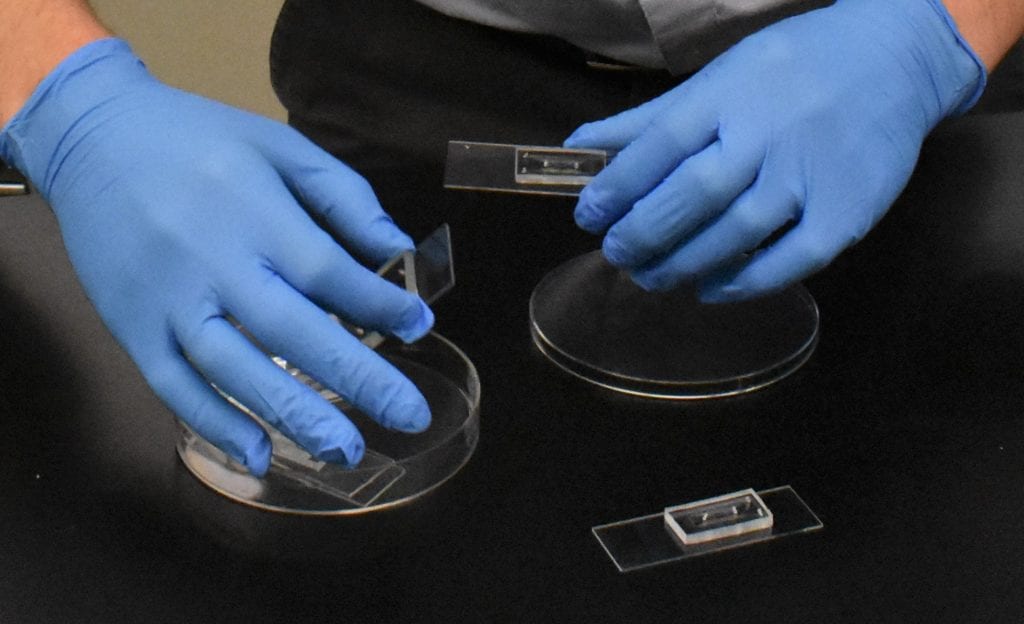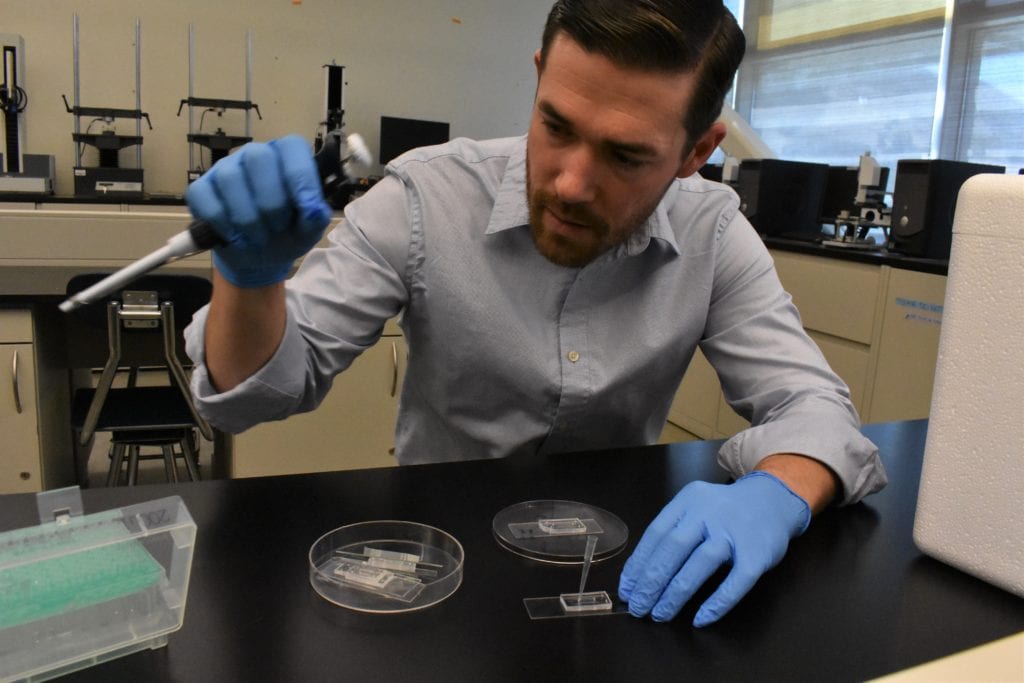As researchers worldwide scramble to develop drugs to treat patients with the COVID-19 virus, policy makers with a sense of urgency are confronting a sobering reality: Drugs require rigorous testing – and that takes time.
“The standard line in the sand answer is that it takes 10-15 years and almost 2 billion dollars to bring a drug to market,” said Chris Heylman, an assistant professor in the Biomedical Engineering Department.
Even the first approved anti-HIV drug took 25 months between the first laboratory demonstration to approval in 1987 – and that was considered remarkable. But Heylman is currently working on “tissue chip” technology that could greatly expediate the time it takes to approve drugs devised to combat cancer.
The CSU recently provided $8,000 in funding to facilitate Heylman’s research. Of that, $6,000 will fund a scholarship for biology student and Frost Scholar Alissa Reed, and the remainder will fund lab supplies.
Tissue chip technology, also called “organs on chips,” are 3-D platforms engineered to support living tissues and cells. Roughly the size of a thumb drive, these chip devices – using stem cells, tissue engineering and microfabrication – mimic complex biological functions, allowing drugs to be tested on organs, tumors, muscles and marrow. Researchers hope to create a “human body on a chip” to gauge how drugs directed at some body parts might have unintended side effects on others.
While researchers are using tissue chip technology to study how COVID-19 is breaking through the human body’s natural defenders, Heylman’s research specifically looks to mimic tumors.
“Our lab is working to create vascularized tumors on a chip to be used in screening novel pharmaceuticals during drug discovery and development,” he said.
Heylman and his students – which includes biomedical and mechanical engineering majors — are building microfluidic devices roughly the size of a penny.

“With the right combination of cells, extracellular matrix proteins, nutrients, and other chemical and mechanical cues, the cells can be directed to resemble human tumors with blood vessels,” Heylman said.
Those vascularized tumors, he added, are very similar to what you would see if you took a biopsy of a tumor from a cancer patient.
“With the tumor model established, we can then introduce drugs to assess how the tumor responds to them as a screening tool to assess if development of a drug should continue on to animal studies and eventually human clinical trials.”
As opposed to vaccines, which are administered before patients have a disease to provide immunity, drugs are prescribed to those who currently have a disease. (Researchers are currently seeking to develop both drugs and vaccines for COVID-19.) Tissue chip technology could be used to test both vaccines and drugs, Heylman said.
Vaccines, like drugs, require rigorous testing even when the disease calls for urgency.
According to the National Institutes of Health, roughly 30 percent of promising medications fail in clinical trials because they are found to be toxic despite promising pre-clinical studies in animal models, and roughly 60- percent fail due to lack of efficacy.
In 2000, the U.S. Food and Drug Administration recalled the “fast track” diabetes drug Rezulin after it was found to cause liver failure, resulting in 63 deaths.
“Each of these steps are getting progressively more expensive, taking up more time and more resources,” Heylman said.
If a model of the human body on a chip could be successfully created, the drug development process would be much more efficient. Drug candidates with issues can be eliminated earlier in the process, freeing up resources to focus on those more likely to be successful in clinical trials. But the technology is still in the early stages. “It has always held a lot of promise,” Heylman said. “But it hasn’t quite come to fruition yet.”
After hearing about Heylman’s work through a graduate student, Reed researched his publications, projects and scientific achievements. “But what stood out to me even more so was the amount of real-world applications that can come from his work,” she said. “The research he is doing is constantly pushing the boundaries of known and unknown in the scientific and medical fields. The results he is finding, and is in search of finding, can help develop new innovative technologies and provide a better comprehension of diseases like cancer.”
Targeting cancer, she added, provides her an opportunity to perform with meaningful work.
“I feel that the ability to test tissue in three dimensions within a controllable environment will provide us with extremely important discoveries about multitudes of medical applications,” she said. “A breakthrough from tissue on a chip might not come today or tomorrow, but I strongly believe that this new method of testing will lead to majors breakthroughs in the scientific and medical fields in the future. “
Heylman’s work, which will continue in the winter quarter, is supported by a Research, Scholarly and Creative Activities (RSCA) grant from the Provost’s Office and the Chancellor’s Office.


